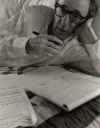


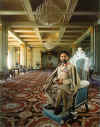
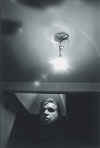

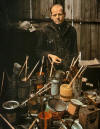

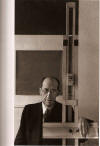

 Arnold Newman
Arnold NewmanEnvironmental portrait
An environmental portrait is a portrait executed in the subject's usual environment, for example their home or workplace, and typically illuminates the subject's life and surroundings. The term is most frequently used of a genre of photography.
Two good rules of thumb when attempting to photograph people in their surroundings:
1. "Half of all location photography is moving furniture."
2. "'Available light' means any light that's available."
Both sayings have been attributed to the great location portraitist Arnold Newman. More importantly, each can help spell the difference between a good environmental portrait and a great one.
 Lewis W. Hine Steamfitter 1920
Lewis W. Hine Steamfitter 1920
http://lcweb2.loc.gov/pp/nclchtml/nclcabt.html
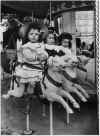 Jules Seeberger Fairground, Paris 1900
Jules Seeberger Fairground, Paris 1900
These shots
sit somewhere between the purposely posed shots of a studio portrait (they are
posed and they are unmistakably Ďportraitsí)
and candid shots which capture people almost incidentally as they go through
their daily life.
Before you select a location and start shooting, spend some time getting to know your subject. Find out where they spend their time, what the rhythm of their life is like and observing their personality. Out of this youíll not only find appropriate locations but will begin to get a feel for the style of shots that might be appropriate and youíll begin the process of helping your subject relax into the photo shoot. If possible it might even be helpful to accompany your subject to some possible locations to see both how they look but also how your subject behaves and interacts there.
Sometimes a location chooses you (itís easy) but on other occasions you need to be quite deliberate and purposeful in making your choice (and it can take a lot of searching). When choosing your environment you ideally want to get one that:
Props can make or break an environmental portrait. If they are subtle and naturally fit within the context of the environment they can be very appropriate and add to the image nicely but youíll want to avoid anything that doesnít quite fit or that potentially distracts the attention of viewers.
The same goes for the clothes that your subject wears. Try to be true to the context without getting too outlandish.
What sets the environmental portrait apart from candid portraits is that you post your subject (itís a fine line and you might end up doing a bit of both in any given shoot). Donít be afraid to direct your subject to sit, stand or act in a certain way that fits with the environment that youíre shooting in. Some of the poses might seem slightly unnatural and dramatic but itís often these more purposely posed shots that are more dramatic and give a sense of style to your shot.
The expression on the face of your subject is also very important in environmental photography and you should consider how it fits with the overall scene. For example if youíre shooting in a formal environment it may not be appropriate to have your subject with a big cheesy smile and you might like a more somber or serious look. Again Ė mix it up to see what does and doesnít work.
There is no right or wrong way to set your camera up for an environmental portrait as it will depend completely upon the effect youíre after and the situation youíre shooting in. You might find that shooting at a smaller aperture (larger numbers) will be appropriate as it will help keep the foreground and background in focus. I generally shoot with a wider focal length in these situations also to give the environment prominence in the shot. Of course this doesnít mean you canít shoot more tightly cropped or with a large aperture and shallow depth of field Ė ultimately anything goes and youíll probably want to mix up your shots a little.
Have you done any environmental portrait photography? What tips would you give other readers? Feel free to share your tips below in comments.
August Sander
Though it was never fully realized or adequately understood, August Sanderís Menschen des 20 Jahrhunderts (People of the 20th Century) was intended as a comprehensive photographic index of the German population, classified into seven groups by social ďtypeĒ: the Farmer; the Skilled Tradesman; the Woman; Classes and Professions; the Artists; the City; and the Last People.
The Nazis confiscated his first publication of the work, but 1800 portraits made mostly in the 1920s and 1930s survive as well as Sanderís notes and plans for the project, which provided the basis for its reconstruction in book and exhibition form by the August Sander Archiv in Cologne.
The uncompromising directness of Sanderís incisive portraits continues to influence artists today.